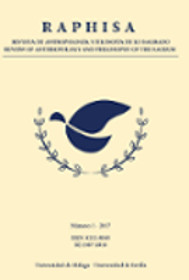La doble dualidad en el mito de Kadr? y Vinat?
DOI:
https://doi.org/10.24310/Raphisa.2022.v7i2.14223Keywords:
Myth pravrtti nivrtti, destiny, liberationAbstract
This paper intents to point out to a fundamental principle of Hindu metaphysics through the mythic language. This is the dynamics from Being to becoming and how it returns. This process is enabled through a complex course that interweaves reflections (chaya, pratibimba) descending from higher consciousness. In this progress, the psyche dimension (both cosmic and individual) arises in such a way that weakens itself in its dispersion. Although paradoxical as it might sound, it is from this level that, under certain conditions, emerges the possibility that enables the spiritual return in itself.
Downloads
Download data is not yet available.
Metrics
Metrics Loading ...
References
Arnau, J. (2019). Upanis?ad, correspondencias ocultas. Girona: Atalanta.
Arnau J. (2021) La mente diáfana: Historia del pensamiento indio. Barcelona: Galaxia Gutenberg
Doniger, W. (1980). The Origins of Evil in Hindu Mythology. Berkeley: University of California Press.
Eliade M. (1956). Imágenes y símbolos. Madrid: Taurus.
Flood, G. (1998). El hinduismo. Madrid: Cambridge University Press.
García Bazán, F. (1982). Neoplatonismo y ved?nta: La doctrina de la materia en Plotino y Shankara. Buenos Aires: Depalma.
González Reinman, L. (2002). The Mah?bh?rata and the Yugas. Nueva York: Peter Lang.
Hiltebeitel, A. (1992). Rethinking the Mah?bh?rata: A Readers Guide to the Education of the Dharma King. Chicago: University of Chicago Press.
Ilarraz, F. y Pujol, O. (Eds.) (2002). La sabiduría del bosque. Antología de las principales upanis?ads. Madrid: Trotta.
Magnone, P. (1993). Rito e ascesi in India. I Quaderni di Avallon, 31, 11-27.
Minkowski, C. Z. (1989). Janamejaya’s Sattra and Ritual Structure. Journal of the American Oriental Society, 109(3), 401- 420.
Monier Williams, M. (1976). English Dictionary. Delhi: Motilal Banarsidass.
Panikkar R. (1993) La experiencia filosófica de la India. Madrid: Trotta
Pujol, O. (2001). Naturaleza y culto. En Maillard, Ch. (Ed.). El árbol de la Vida. La naturaleza en el arte y las tradiciones de la India. Barcelona: Kairós.
Sankara (2011). El tratado de las mil enseñanzas (Upades?as?ahsr?). (O. Cattedra, Trad.). Mar del Plata: EUDEM.
Tucci, G. (1978). Teoría y práctica del mandala. Buenos Aires: Dédalo.
Van Buitenen, J. A. B. (Ed.) (1980). The Mah?bh?rata. Chicago: University of Chicago Press. 1973, London
Wulff Alonso, F. (2008). Grecia en la India: El repertorio griego del Mah?bh?rata. Madrid: Akal.
Zolla, E. (2002). La nube en el telar, razón e irracionalidad en Oriente y Occidente. Barcelona: Paidós.
Arnau J. (2021) La mente diáfana: Historia del pensamiento indio. Barcelona: Galaxia Gutenberg
Doniger, W. (1980). The Origins of Evil in Hindu Mythology. Berkeley: University of California Press.
Eliade M. (1956). Imágenes y símbolos. Madrid: Taurus.
Flood, G. (1998). El hinduismo. Madrid: Cambridge University Press.
García Bazán, F. (1982). Neoplatonismo y ved?nta: La doctrina de la materia en Plotino y Shankara. Buenos Aires: Depalma.
González Reinman, L. (2002). The Mah?bh?rata and the Yugas. Nueva York: Peter Lang.
Hiltebeitel, A. (1992). Rethinking the Mah?bh?rata: A Readers Guide to the Education of the Dharma King. Chicago: University of Chicago Press.
Ilarraz, F. y Pujol, O. (Eds.) (2002). La sabiduría del bosque. Antología de las principales upanis?ads. Madrid: Trotta.
Magnone, P. (1993). Rito e ascesi in India. I Quaderni di Avallon, 31, 11-27.
Minkowski, C. Z. (1989). Janamejaya’s Sattra and Ritual Structure. Journal of the American Oriental Society, 109(3), 401- 420.
Monier Williams, M. (1976). English Dictionary. Delhi: Motilal Banarsidass.
Panikkar R. (1993) La experiencia filosófica de la India. Madrid: Trotta
Pujol, O. (2001). Naturaleza y culto. En Maillard, Ch. (Ed.). El árbol de la Vida. La naturaleza en el arte y las tradiciones de la India. Barcelona: Kairós.
Sankara (2011). El tratado de las mil enseñanzas (Upades?as?ahsr?). (O. Cattedra, Trad.). Mar del Plata: EUDEM.
Tucci, G. (1978). Teoría y práctica del mandala. Buenos Aires: Dédalo.
Van Buitenen, J. A. B. (Ed.) (1980). The Mah?bh?rata. Chicago: University of Chicago Press. 1973, London
Wulff Alonso, F. (2008). Grecia en la India: El repertorio griego del Mah?bh?rata. Madrid: Akal.
Zolla, E. (2002). La nube en el telar, razón e irracionalidad en Oriente y Occidente. Barcelona: Paidós.
Downloads
Published
2022-04-01
How to Cite
Cattedra, O. (2022). La doble dualidad en el mito de Kadr? y Vinat?. Review of Anthropology and Philosophy of the Sacrum, 6(2), 75–87. https://doi.org/10.24310/Raphisa.2022.v7i2.14223
Issue
Section
Miscellaneous
License
License permitted by the journal: Public Domain. Authors retain the copyright and full publishing rights without restrictions.






